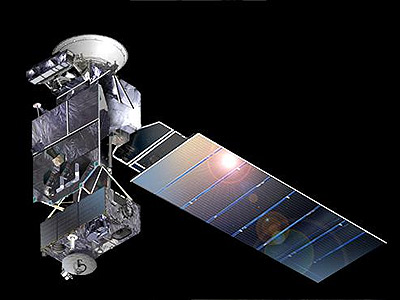Thank you very much for visiting Gunter's Space Page. I hope that this site is useful and informative for you.
If you appreciate the information provided on this site, please consider supporting my work by making a simple and secure donation via PayPal. Please help to run the website and keep everything free of charge. Thank you very much.
STPSat 6
 S
SSTPSat 6 [DoD]
STPSat 6 is a planned experimental spacecraft for the Department of Defense's Space Test Program (STP).
The satellite is based on Northrop Grumman Innovation Systems's (NGIS) (formerly Orbital ATK's) high-end modular A-500 bus, which another U.S. government agency bought for a different geosynchronous mission (DARPA's Phoenix program) but transferred to the Space Test Program after deciding it didn’t need it. The satellite will be directly inserted into an orbit slightly above the geostationary orbit.
STPSat-6 will carry nine experiments into a geosynchronous orbit:
- Space and Atmospheric Burst Reporting System-3 (SABRS-3) by the National Nuclear Security Administration, , which provides nuclear detonation detection and space environment data, and is designed to complement nuclear detonation detectors aboard current GPS spacecraft. SABRS detects, locates, and reports nuclear detonations (NUDETs) in the earth’s atmosphere and in near space in near-real time. The payload augments U.S. operational NUDET detection capabilities, serving as an operational element of the U.S. NUDET Detection System (USNDS).
- Laser Communications Relay Demonstration (LCRD) by NASA, which was originally planned to be flown as a hosted payload on an SSL built commercial communications satellite. LCRD provides high data rate optical communication services to meet the growing need for higher data rates in space science and exploration. LCRD operationally demonstrates bi-directional uplink and downlink optical communications. The LCRD optical links interface with the spacecraft Ka band links to enable on-board hand-off between RF and Optical for both uplink and downlink.
- Compact Environmental Anomaly Sensor Experiment III (CEASE) – Air Force Research Laboratory (AFRL)
- Falcon Solid-State Energetic Electron Detector (FalconSEED) – U.S. Air Force Academy
- Rad-Hard Electronics Memory Experiment (RHEME) – AFRL
- Space & Endo-Atmospheric NUDET Surveillance Experiment and Risk-Reduction (SENSER) by NNSA, will test critical technologies in the space environment before production and integration into the next generation of systems to reduce the development risk for future nuclear explosion detection sensors
- Strontium Iodide Radiation Instrumentation (SIRI) – Naval Research Lab
- Ultraviolet Spectro-Coronagraph Pathfinder (UVSC Pathfinder) by NASA and Naval Research Lab, which is to use a new UV coronagraph design concept to make the first remote-sensing measurement of a suprathermal particle distribution in the corona capable of seeding SEP acceleration.
- one unidentified experiment
Launch of the satellite is planned as the primary payload on the STP-3 launch in 2018, to be competively bid between an ULA Atlas-5 or a SpaceX Falcon-9 v1.2 (Block 5) rocket. In June 2017, am Atlas-5(551)˛ was selected to launch the STP-3 mission, including an integrated propulsive EELV Secondary Payload Adapter (LDPE 1) holding up to six payloads, in 2019.
| Nation: | USA |
|---|---|
| Type / Application: | Technology |
| Operator: | US Air Force (USAF) STP (Space Test Program) |
| Contractors: | Northrop Grumman Innovation Systems (NGIS) (formerly Orbital ATK) |
| Equipment: | SABRS-3, LCRD, CEASE, FalconSEED, RHEME, SENSER, SIRI, UVSC Pathfinder, ? |
| Configuration: | A-500 bus |
| Propulsion: | 12 × 22 N REAs |
| Power: | 2 deployable solar arrays, batteries |
| Lifetime: | 8-10 years |
| Mass: | 2572 kg |
| Orbit: | GEO |
| Satellite | COSPAR | Date | LS | Launch Vehicle | Remarks | |
|---|---|---|---|---|---|---|
| STPSat 6 | 2021-118A | 07.12.2021 | CC SLC-41 | Atlas-5(551)˛ | with LDPE 1, Ascent |
References:
- Barbara Mangannis Braun, Sam Myers Sims, James McLeroy, Ben Brinning: Breaking (Space) Barriers for 50 years: The Past, Present, and Future of the DoD Space Test Program
- Homeland Preparedness News: NNSA to deliver next generation of nuclear detection capabilities, 26 March 2018
- Northrop Grumman: STPSat-6 – Advanced Spacecraft for the USSF, NNSA, and NASA
Further STP missions:
|
